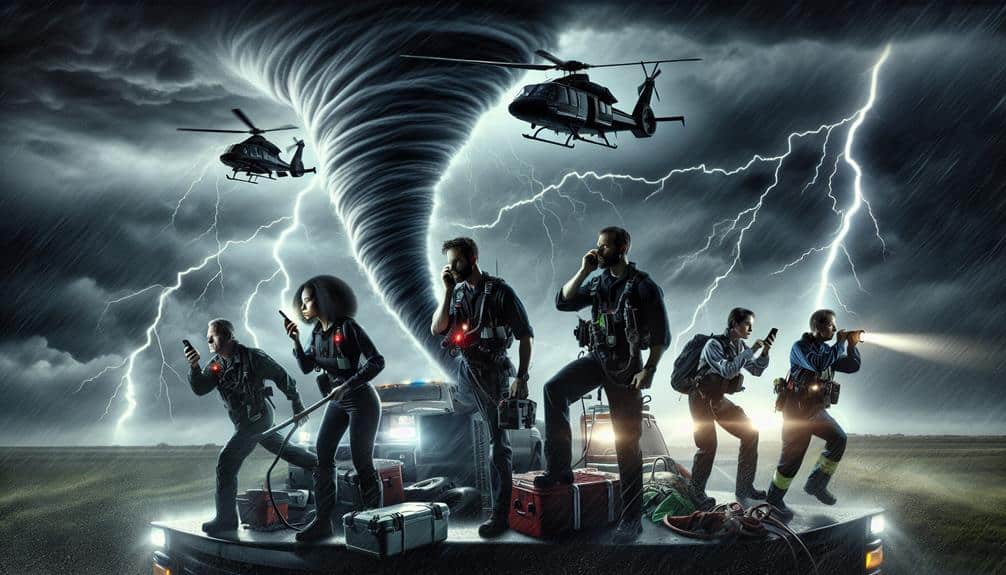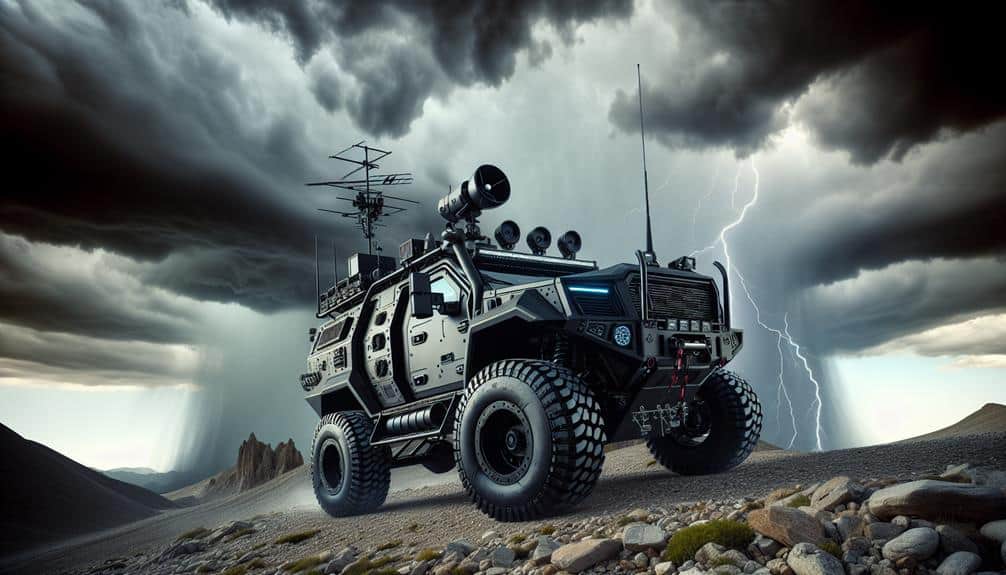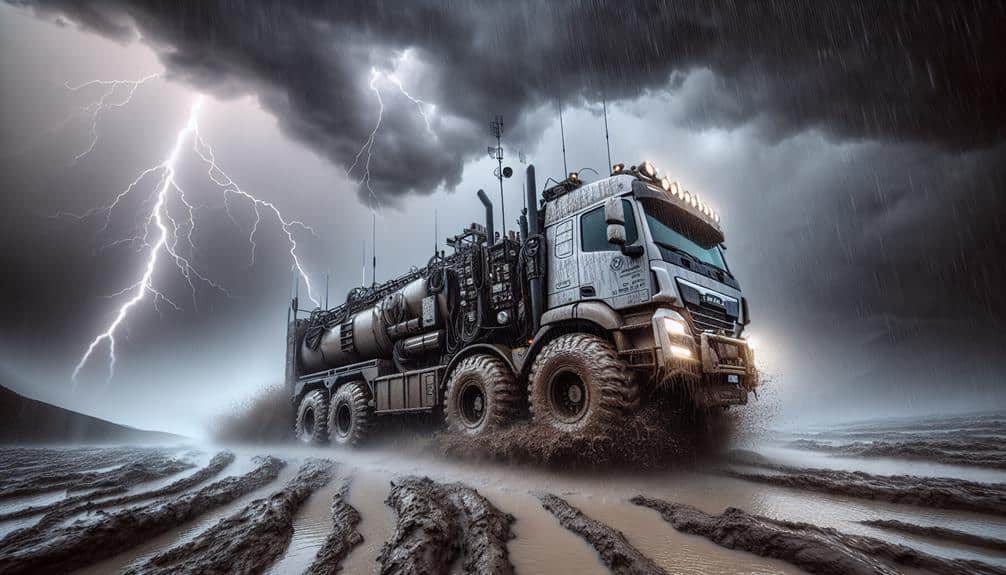Communication devices are essential for storm chasing because they provide real-time weather updates, enhance team coordination, and guarantee safety during emergencies. We use high-resolution radar and mobile data networks for precise storm analysis. Advanced location sharing tech and encrypted radios help us coordinate effectively. Reliable communication lets us handle emergencies swiftly and log crucial data accurately. Finally, maintaining clear channels with emergency services and the public guarantees timely and safe responses. By understanding the technical intricacies, we can see how these devices revolutionize storm chasing methods.
Key Points
- Communication devices provide real-time weather updates essential for accurate storm tracking and decision-making.
- They ensure constant coordination among team members, optimizing safety and observational effectiveness.
- Reliable communication is crucial for immediate alerts and coordinated responses during emergency situations.
- Devices enable meticulous tracking and data logging, enhancing post-chase analysis and scientific contributions.
Real-Time Weather Updates
In the world of storm chasing, real-time weather updates are essential for making informed decisions and ensuring safety. Our ability to monitor weather conditions has greatly improved with advancements in technology.
High-resolution radar systems, satellite imagery, and sophisticated forecasting models allow us to analyze storm patterns with unprecedented accuracy. Leveraging these tools, we can predict severe weather events and adjust our strategies accordingly.
Effective weather monitoring relies on robust remote communication and reliable network coverage. We depend on mobile data networks to access up-to-the-minute weather information. In regions with poor network coverage, satellite communication systems become indispensable. These technologies enable us to obtain critical updates even in the most remote locations, where traditional communication methods might fail.
Technology advancements in weather monitoring have revolutionized storm chasing. Portable weather stations, equipped with sensors to measure temperature, humidity, and wind speed, provide real-time data directly to our mobile devices. This immediate access to precise information allows us to make split-second decisions, enhancing our ability to navigate safely through volatile environments.
Coordination Among Team Members
While real-time weather updates keep us informed, effective storm chasing hinges on impeccable coordination among team members. We rely on seamless team coordination to interpret rapidly changing data and adjust our strategies on the fly. Communication devices are essential for relaying critical information, ensuring every team member is synchronized in their actions.
Location sharing technology plays a pivotal role in this coordination. By continuously updating each other's positions, we can maintain safe distances from the storm while optimizing our observational vantage points. This real-time location sharing also allows us to divide tasks effectively, ensuring that no critical data is missed and that we cover the storm thoroughly.
Moreover, having robust communication channels reduces the risk of miscommunication, which can be fatal in high-stakes environments. We use encrypted radios, GPS trackers, and mobile apps to maintain a constant flow of information. These tools help us make informed decisions swiftly, whether it's repositioning our vehicles or deploying specialized equipment.
In essence, effective team coordination and precise location sharing are non-negotiable for successful storm chasing. They enable us to act as a cohesive unit, maximizing our observational capabilities and ensuring our safety.
Emergency Situations Handling
Handling emergency situations demands a well-coordinated response and rapid decision-making to safeguard the safety of all team members. When we're out storm chasing, the unpredictable nature of severe weather means we must be prepared for any scenario. Our ability to execute an effective emergency response hinges on robust communication protocols.
First, it's crucial that all team members are equipped with reliable communication devices. These tools enable us to relay real-time updates and issue immediate alerts when danger approaches. We establish predefined communication protocols to guarantee that everyone knows precisely how to react in various emergency scenarios, whether it's a sudden change in storm direction or a vehicle malfunction.
Additionally, we utilize multiple communication channels, such as radios, satellite phones, and mobile apps, to maintain constant contact. This redundancy is essential; if one system fails, others can compensate, ensuring no team member is left uninformed.
In high-stress situations, clear and concise communication can mean the difference between life and death. We also conduct regular drills to test our emergency response, refining our protocols to address any weaknesses discovered.
Tracking and Data Logging
Effective tracking and data logging are vital for accurately monitoring storm patterns and making informed decisions during our chases. By leveraging advanced communication devices, we enhance our tracking accuracy, guaranteeing that we capture real-time data on storm movements. This precision allows us to anticipate changes in storm behavior, which is critical for staying ahead of potentially dangerous weather conditions.
Our ability to log data meticulously while on the move provides a detailed record of storm paths, intensities, and other important variables. These records are essential for post-chase analysis, helping us refine our strategies and improve future predictions.
Also, the data we collect can be shared with meteorological agencies, contributing to a broader scientific understanding and aiding in emergency response efforts.
In emergency situations, having access to precise tracking information allows us to coordinate effectively with other storm chasers and emergency teams. Our real-time updates can guide evacuation plans and resource allocation, enhancing overall safety.
The integration of accurate data logging into our communication systems ensures that every piece of information is captured and utilized to its fullest potential, empowering us to make decisions swiftly and effectively under pressure.
Public Safety Communication

Building on our detailed data logging and tracking capabilities, we must now focus on how effective public safety communication can greatly improve outcomes during storm chases. Effective communication channels are essential for relaying timely information to emergency services and the public. When severe weather conditions arise, the ability to disseminate real-time data can mean the difference between life and death.
By adhering to strict safety protocols, we guarantee that every team member is equipped with the necessary tools to communicate efficiently. This includes using radios, satellite phones, and mobile apps specifically designed for emergency communication. These tools allow us to provide up-to-the-minute updates on storm paths, intensity, and potential hazards.
Furthermore, public safety communication isn't just about technology. It involves understanding how to communicate effectively under pressure. Clear, concise messages help authorities make quick, informed decisions. For instance, when we relay data to local authorities, they can implement evacuation plans faster, thereby safeguarding more lives.
In storm chasing, freedom isn't just about the thrill of the chase; it's about making sure that our pursuit of knowledge doesn't come at the expense of public safety. Effective communication and rigorous safety protocols are the cornerstones of this mission.
Frequently Asked Questions
What Types of Communication Devices Are Most Commonly Used by Storm Chasers?
We commonly use satellite phones and walkie talkies for reliable communication during storm chasing. Satellite phones guarantee connectivity without cell towers, while walkie talkies provide direct, immediate communication between team members in remote areas.
How Do Communication Devices Improve the Accuracy of Storm Predictions?
Did you know that real-time data analysis can improve forecasting accuracy by up to 30%? By using communication devices, we can quickly share critical storm data, enhancing our ability to predict storm paths and keep everyone safe.
Are There Specific Apps or Software That Storm Chasers Rely on for Communication?
We rely heavily on apps like RadarScope for real-time data, Zello for communication, and Spotter Network for GPS tracking. Emergency alerts, live streaming, and social media engagement tools are essential for safety and situational awareness.
Imagine the swirling clouds above; we can use communication devices to gather and share real-time data, enhancing meteorological research. This capability guarantees we stay informed and free to make precise, life-saving decisions during storms.
How Do Storm Chasers Ensure Their Communication Devices Remain Operational During Severe Weather?
We guarantee our communication devices remain operational during severe weather by following emergency protocols, implementing backup plans, and prioritizing weatherproofing and device maintenance. These steps maximize reliability and keep us connected, even in extreme conditions.


